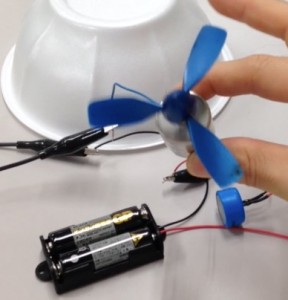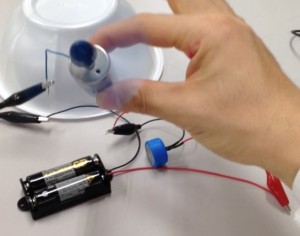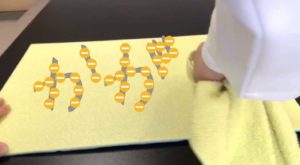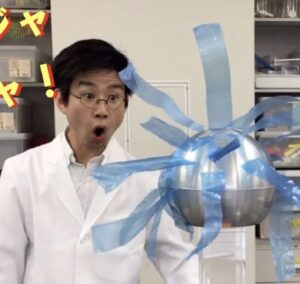The Capacitor Riddle: Why Does the Motor Spin and Then Stop?
I’m Ken Kuwako, your Science Trainer. Every day is an experiment.
Hey everyone, here’s a circuit riddle for you! If you connect a battery and a motor with wires, the motor will obviously spin, right? But what happens if you introduce a component called a “capacitor” into the middle of that circuit? Will the motor keep spinning? Or will it stop dead in its tracks?
A capacitor is a component designed to store electrical energy. Structurally, it consists of two metal plates (electrodes) separated by a “dielectric,” which is an electrical insulator. As you can see from a circuit diagram, the plates aren’t connected. In other words, the circuit is broken right where the capacitor sits.
“Wait, if the circuit is broken, no electricity should flow. The motor shouldn’t spin at all!”
This kind of “I wonder what will happen?” curiosity is the very gateway to science! Let’s find out by observing the experiment ourselves.
Does the Motor Spin When a Capacitor is Connected in Series?
What you’ll need:
Capacitor (1F *), Motor, Battery (2 cells)
“F (Farad)” is the unit for a capacitor’s electrical storage capacity. 1F is a very large capacity, which makes the experiment easier to observe.
Procedure:
Connect the capacitor, motor, switch, and battery in series.
Prepare to observe the motor before flipping the switch.
Flip the switch and observe the motor for a while.
Here is a video of the experiment in action. Take a look!
What did you see? Surprisingly, the moment the switch is closed (the circuit is completed), the motor definitely starts spinning! However, if you watch closely, the motor’s rotation gradually slows down… and eventually stops completely. It spins for a moment,
Then, after enough time passes, it stops.

This is an important phenomenon often tested in exams. But why did current flow, even for a moment, through the supposedly broken circuit section?
Current Only Flows During “Charging”
The secret lies in the capacitor’s function: “charging.” Imagine the capacitor as a dam (or a bucket) for storing electricity. The moment you flip the switch, electricity (water) rushes out from the battery (the water source). This electricity (water) flows through the motor (the water wheel) and rushes into the empty capacitor (the dam).
Current flows in the circuit only while electricity is filling up the capacitor (dam). The motor rotates due to the force of this electricity passing through it. Once the capacitor (dam) is full of electricity (Charging Complete), no more electricity can flow in. When the flow of electricity stops, the motor (water wheel) also stops.
Seeing the motor’s rotation gradually weaken as the capacitor stores electricity is truly fascinating! We strongly encourage you to question what’s in your textbooks—to ask “Is this really true?”—and try it out for yourself! Even things you take for granted can be surprising when they happen right in front of you, leading to a much deeper understanding of the mechanism.
Inquiries and Requests
Bringing the wonders and excitement of science closer to you! We provide easy-to-understand summaries of fun science experiments you can do at home, along with tips and tricks. Feel free to browse around!
The contents of this science blog have been published in a book. Find out more here
About the administrator, Ken Kuwako, click here
For various requests (writing, lectures, science classes, TV supervision/appearances, etc.), click here * Article updates are posted on X!
![]() We stream experiment videos on the Science Material Channel!
We stream experiment videos on the Science Material Channel!



